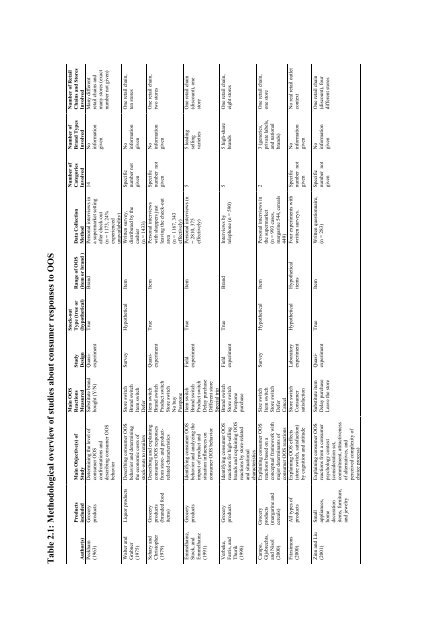Understanding Consumer Reactions to Assortment Unavailability
Understanding Consumer Reactions to Assortment Unavailability
Understanding Consumer Reactions to Assortment Unavailability
You also want an ePaper? Increase the reach of your titles
YUMPU automatically turns print PDFs into web optimized ePapers that Google loves.
Table 2.1: Methodological overview of studies about consumer responses <strong>to</strong> OOS<br />
Number of Retail<br />
Chains and S<strong>to</strong>res<br />
Involved<br />
Many different<br />
retail chains and<br />
many s<strong>to</strong>res (exact<br />
number not given)<br />
Number of<br />
Brand Types<br />
Involved<br />
Number of<br />
Categories<br />
Involved<br />
14 No<br />
Main OOS<br />
<strong>Reactions</strong><br />
Measured<br />
Substitute brand<br />
bought (Y/N)<br />
Main Objective(s) of<br />
Study<br />
Determining the level of<br />
consumer OOS<br />
confrontations and<br />
describing consumer OOS<br />
behavior<br />
Products<br />
included<br />
Grocery<br />
products<br />
Author(s)<br />
Peckham<br />
(1963)<br />
information<br />
given<br />
One retail chain,<br />
ten s<strong>to</strong>res<br />
No<br />
information<br />
given<br />
Specific<br />
number not<br />
given<br />
S<strong>to</strong>ck-out<br />
Study Type (true or Range of OOS Data Collection<br />
Design (hypothetical) (item or brand ) Method<br />
Quasi- True Brand Personal interviews in<br />
experiment<br />
a supermarket setting<br />
after check-out<br />
(n = 1173, 24%<br />
experienced<br />
unavailability)<br />
Survey Hypothetical Item Written survey,<br />
distributed by the<br />
cashier<br />
(n = 1433)<br />
Quasi- True Item Personal interviews<br />
experiment<br />
with shoppers just<br />
leaving the check-out<br />
area<br />
(n = 1167, 343<br />
effectively)<br />
Field True Item Personal interviews (n<br />
experiment<br />
= 2810, 375<br />
effectively)<br />
S<strong>to</strong>re switch<br />
Brand switch<br />
Item switch<br />
Defer<br />
Item switch<br />
Brand switch<br />
Product switch<br />
S<strong>to</strong>re switch<br />
No buy<br />
Postpone<br />
Item switch<br />
Brand switch<br />
Product switch<br />
Delay purchase<br />
Different s<strong>to</strong>re<br />
Special trip<br />
Brand switch<br />
S<strong>to</strong>re switch<br />
Postpone<br />
purchase<br />
Liquor products Describing consumer OOS<br />
behavior and determining<br />
the economic costs of<br />
s<strong>to</strong>ck-outs <strong>to</strong> retailers<br />
Grocery Describing and explaining<br />
products consumer OOS responses<br />
(branded food from s<strong>to</strong>re- and product-<br />
items)<br />
related characteristics<br />
Walter and<br />
Grabner<br />
(1975)<br />
One retail chain,<br />
two s<strong>to</strong>res<br />
No<br />
information<br />
given<br />
Specific<br />
number not<br />
given<br />
Schary and<br />
Chris<strong>to</strong>pher<br />
(1979)<br />
One retail chain<br />
(discount), one<br />
s<strong>to</strong>re<br />
5 5 leading<br />
selling<br />
varieties<br />
Identifying consumer OOS<br />
behavior and analyzing the<br />
impact of product and<br />
situation influences on<br />
consumer OOS behavior<br />
Grocery<br />
products<br />
Emmelhainz,<br />
S<strong>to</strong>ck, and<br />
Emmelhainz<br />
(1991)<br />
One retail chain,<br />
eight s<strong>to</strong>res<br />
5 5 high-share<br />
brands<br />
True Brand Interviews by<br />
telephone (n = 590)<br />
Field<br />
experiment<br />
Identifying consumer OOS<br />
reactions for high-selling<br />
brands and explaining OOS<br />
reactions by s<strong>to</strong>re-related<br />
and situational<br />
characteristics<br />
Explaining consumer OOS<br />
reactions based on a<br />
conceptual framework with<br />
major determinants of<br />
consumer OOS reactions<br />
Explaining OOS effects<br />
(s<strong>to</strong>re switch, satisfaction)<br />
by cognition and attitude<br />
Grocery<br />
products<br />
Verbeke,<br />
Farris, and<br />
Thurik<br />
(1998)<br />
One retail chain,<br />
one s<strong>to</strong>re<br />
2 3 (generics,<br />
private labels,<br />
and national<br />
brands)<br />
Survey Hypothetical Item Personal interviews in<br />
the supermarket<br />
(n = 993 cases,<br />
margarine 544, cereals<br />
Size switch<br />
Item switch<br />
S<strong>to</strong>re switch<br />
Defer<br />
Cancel<br />
S<strong>to</strong>re switch<br />
<strong>Consumer</strong><br />
satisfaction<br />
Grocery<br />
products<br />
(margarine and<br />
cereals)<br />
Campo,<br />
Gijsbrechts,<br />
and Nisol<br />
(2000)<br />
No real retail outlet<br />
context<br />
No<br />
information<br />
given<br />
Specific<br />
number not<br />
given<br />
449)<br />
Four experiments with<br />
written surveys.<br />
Hypothetical Hypothetical<br />
items<br />
Labora<strong>to</strong>ry<br />
experiment<br />
All types of<br />
products<br />
Fitzsimons<br />
(2000)<br />
One retail chain<br />
(discount), four<br />
different s<strong>to</strong>res<br />
No<br />
information<br />
given<br />
Specific<br />
number not<br />
given<br />
True Item Written questionnaire,<br />
(n = 283)<br />
Quasiexperiment<br />
Substitute item<br />
Delay purchase<br />
Leave the s<strong>to</strong>re<br />
Explaining consumer OOS<br />
reactions from a consumer<br />
psychology context<br />
(consideration set,<br />
commitment, attractiveness<br />
of alternatives, and<br />
perceived complexity of<br />
choice process)<br />
Small<br />
appliances,<br />
home<br />
decoration<br />
items, furniture,<br />
and jewelry<br />
Zinn and Liu<br />
(2001)

















